Consider as cultural capital of Laos, Luang Prabang is one of the most desired destinations in the country. Find out the best time to visit, things to do and top tourist attractions with our Luang Prabang Travel Guide.
The ancient town of Luang Prabang is the former Royal Capital and a UNESCO World Heritage Site. Located 700 meters above sea level in northern Laos, it’s on the peninsula surrounded by mountains at the confluence of the Nam Khan and Mekong Rivers and beneath a temple-topped hill.
Luang Prabang is considered as the heart of Laotian culture, where you can see traditional wooden houses and hints of European architecture, royal structures, and many Buddhist shrines.
This ancient town is an ideal place for spiritual contemplation, attracting those looking to learn about Buddhism as its untouched natural landscapes surround, including cascading waterfalls, lush mountains, along with the Mekong and Nam Khan rivers.
The historic quarter of the town is dedicated to tourism, travelers love Luang Prabang for its peaceful life and tasty food, and the settings.
Best time to visit
Luang Prabang is influenced by a tropical climate with warm weather year-round, typical of Southeast Asia with a dry season from October to May and a rainy season from June to September.
The best time to visit Luang Prabang is from October to March when the weather is more comfortably dry with pleasant average temperatures. Remember that it can also get fairly crowded, especially in January & during the time of festivals. Thus, be sure to book ahead if you are traveling to Luang Prabang during this time of the year.
On the other hand, during the wettest months of the year, especially when the heavy rainfall comes with the southwest monsoon from August to September, the Mekong sometimes may get flooded. Yet this is considered as one of the best times to see dragon boats racing on the Nam Khan river. April to June is the warmest time of year when Luang Prabang experiences high levels of humidity and high average temperatures, generally mid-April where highs are frequently around 97.4°F (36.3°C) with temperatures rarely dropping below 72.2°F (22.3°C) at night.
Things to see and do
Kuang Si Falls
The Kuang Si Falls, a three-tiered waterfall, also known as the Tat Kuang Si Waterfalls, located about 29 kilometers south of Luang Prabang.
The special structure of this waterfall, with pools atop a steep hillside, lead to the main fall with a drop of 60 meters, the water flows into a turquoise blue pool before continuing downstream. Many cascades make this waterfall of top favorite destinations for tourists once they stay in Luang Prabang.
There are walkways and bridges to ease your visit. Most of the pools are open to swimming, making it a really good place to escape the heat.
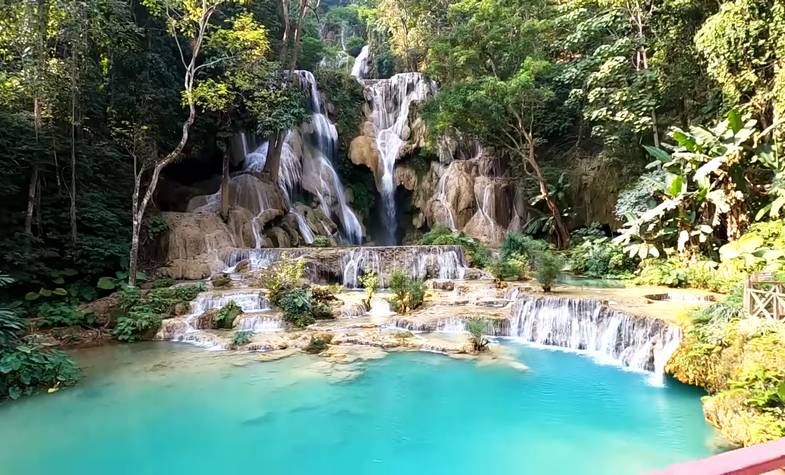 \
\
Kuang Si Falls, Luang Prabang, Laos
This site is open daily from 08:30 to 17:30 to welcome tourists, with an entrance fee of 20,000 Kip.
Waterfall visits can combine with a stopover along the way to take some walks in a Hmong village the older female villagers still dress in traditional costumes.
Wear proper footwear as the trails can rather get slippery, especially during the wet season.
Mandalao Elephant Village Sanctuary
Located deep inside the jungle, at about a 30-minute drive from Luang Prabang, Mandalao Elephant Sanctuary covers an area of 80 hectares of forest, is an incredible place where elephants can stroll freely. Tourists visiting this place will surely find peace in their soul, by getting in touch in a gentle treatment with the elephants.
The beautiful jungle, combined with experienced staff and majestic elephants make a perfect setting to find out more about these amazing animals while gently interacting with them.
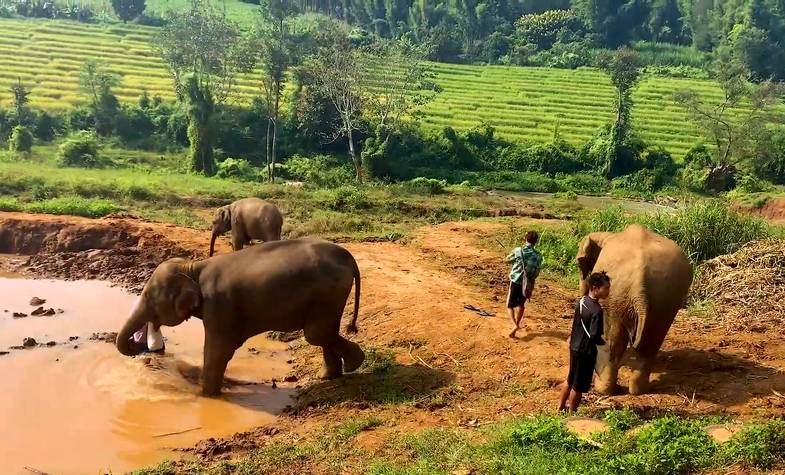
Mandalao Elephant Village Sanctuary, Luang Prabang, Laos
It was founded by Michael Vogler, Prasop Tipprasert, and Kellen Johnson, three people passionate about animals. The founders of Mandalao would like to bring to these elephants a dignified and comfortable life in harmony with nature. They wanted to create a place where abuse is replaced by care, a place where animal cruelty no longer exists. This is how Mandalao was born.
Old Quarter – Luang Prabang
Located in the North of Mount Phusi, Old Quarter Luang Prabang is a well-known tourist hub offering a gateway to a number of the city’s temples including Wat Xieng Thong, Wat Sensoukharam, and many other tourist attractions.
Walk along the streets with picturesque traditional houses, colonial-style villas, and Lao Buddhist temples at Old Quarter Luang Prabang, part of a bustling UNESCO-protected city area packed with history and culture. Night market, shops, and restaurants set in pleasant two-story houses on clean, quiet streets give you a different feeling from the madness of other big Asian cities.
This is no doubt a roam around this quiet and quaint quarter feels like a step back in time.
The ideal time to visit: between 8:00 AM to 10:00 AM.
Pak Ou Caves
Pak Ou (mouth of the Ou river) Caves, situated 25 km north of Luang Prabang, at the junction of the Mekong River and Ou River, have a very long history of thousands of years.
The Caves include 2 caves: Tham Ting (lower cave) and the Tham Theung (upper cave), on the west side of the Mekong river, have a great overlook to the river. Both upper and lower caves are accessed by steps, which can get slippery during the rainy season. If visiting the upper cave, you will need to bring a flashlight.
The caves are well-known for their miniature Buddha sculptures. They are various in size and sharps (intact or chipped, very or very small), taking many different positions, including meditation, teaching, peace, rain, and reclining (nirvana).
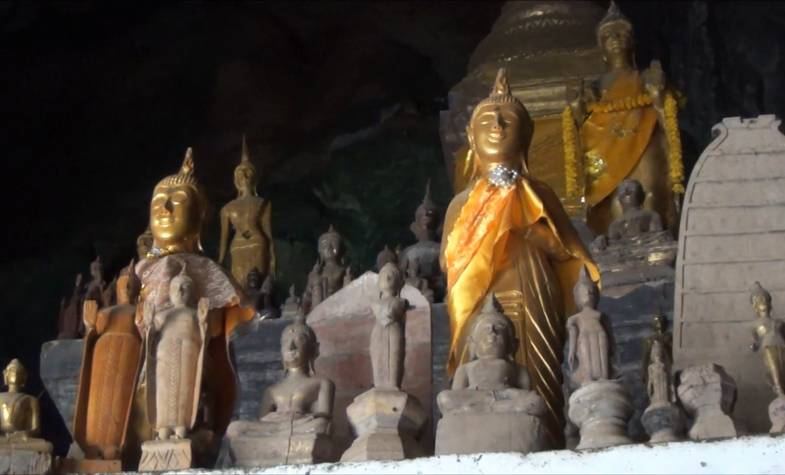
Pak Ou Caves, Laos
Recently, thanks to the Swedish government, there is a new road to reach Park Ou, passing by Shang Hay, a famous village with a jar and local whiskey fabrications, but the most convenient way is taking a boat trip upstream the Mekong river in about 2hours (one way). While cruising, tourists can admire the beautiful scenery and peaceful life of the local people on both sides of the river.
Park Ou caves is also a sacred pilgrimage of locals, so please be well-dressed during this visit with long pants and covered shoulders.
Opening hours from 8:00 AM till 5:00 PM.
Pha Tad Ke Botanical Garden
Opened in 2017 as the first botanical garden in Laos with the mission to collect and research the plants in the country and teach the public about horticulture and botany, the garden is a peaceful spot to read, take a stroll or perfect some yoga poses. The entry price is quite expensive but worthy to spend your time here for an orchid talk (11 am or 3 pm), a one-hour bamboo handicraft workshop (10 am or 2 pm), and free herbal-tea tastings in a cafe overlooking a lotus pond.
To get to Pha Tad Ke Botanical Garden, you just take a 15-minute ride down by boat across the Mekong River
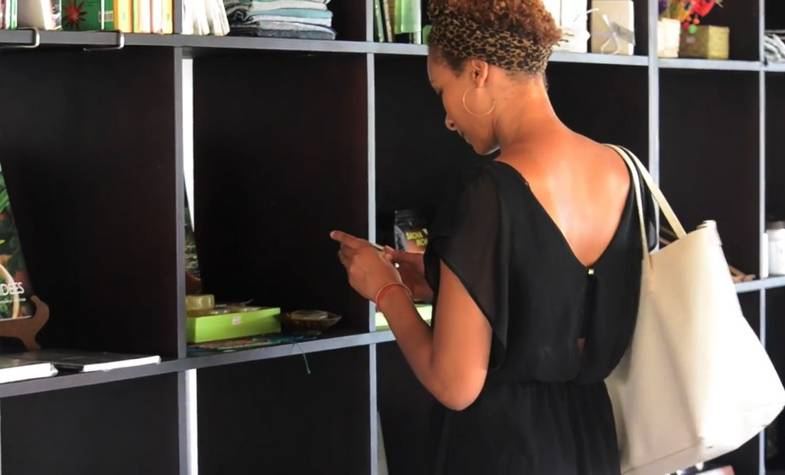
Pha Tad Ke Botanical Garden is famous for its herbal-tea
Phu Si/ Phou Si Hill
Located in the ancient town centre and this is where you have an eye-bird view of the whole area of Luang Prabang from the top, the abrupt 100m-tall hill of Phu Si is crowned by a 24m gilded stupa called That Chomi - one of the most visited sacred sites here built-in 1804, by night the 24m gilded stupa gleams like a chandelier. It's best visited at dawn or sunset to take in the views. It can be viewed from a distance all around the town, especially when floodlit at night, the structure seems to float in the misty air.
The best part of climbing up the top is the series of city views. It is not a steep climb from the bottom and sunrise and sunset are the most sensible and worthwhile times to go up.
Ascending Mount Phousy from the north side (329 steps), pass through the moldy Wat Pa Huak (Pa Houak), the “Monastery of the Bamboo Forest”. Reaching That Chomsi is also possible from the east and south sides. If you don't climb beyond That Chomsi, it is free to visit the monastery.
You can take excellent photos of the national museum complex from the steps that descend to Thanon Sisavangvong.
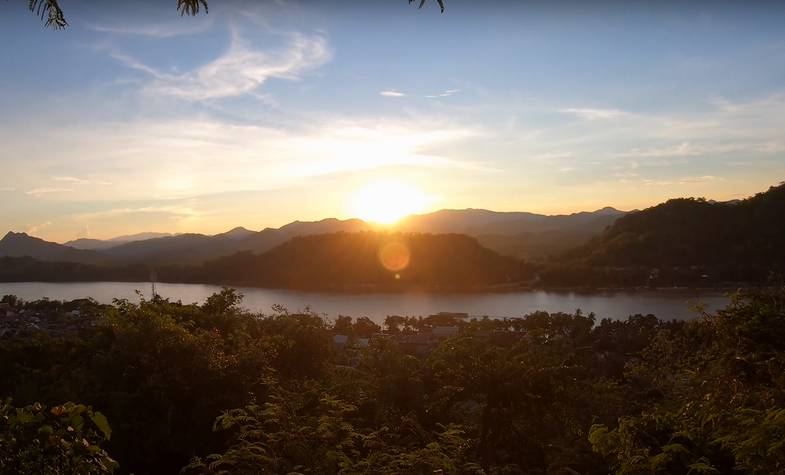
Phou Si Hill, Laos
Royal Palace Museum
Also known as the National Museum, “Haw Kham” - the “Golden Palace '' was once Laos’ Royal Palace, used to be the residence of the Laos Royal family until the end of Laos’ monarch in 1975. The former palace is located on the banks of the Mekong River and the bottom of Phou Si Hill. The palace houses a lot of historical items with interesting stories behind where you will learn more about Lao history and culture. It is worth a visit.
Evoking traditional Lao and French beaux-arts styles, the former Royal Palace was built in 1904 and was home to King Sisavang Vong (1904–59), whose statue stands outside.
Inside the Throne Hall, the Lao crown jewels are on display. The rooms where the Royal Family lived at the rear and sides of the property. The Royal Palace Museum also has an exhibition of the late king’s collection of cars, many of which were imported from America.
The Pha Bang - an 83cm-tall gold-alloy Buddha, is the most historically resonant treasure of Laos. To find it, head to Wat Ho Pha Bang (Haw Pha Bang) in the southeast corner of the palace gardens.
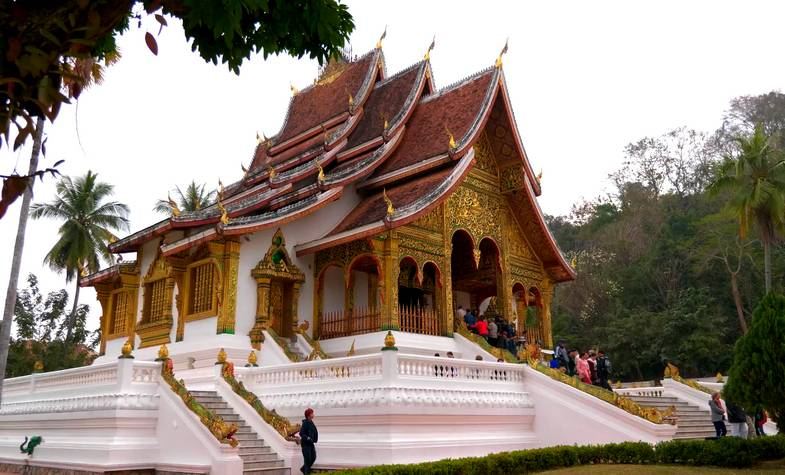
Royal Palace Museum, Luang Prabang, Laos
Inside the museum, footwear and photography are banned and you must leave your bags in a locker room on the left side of the entrance. An audio tour is also available to visitors.
During the Royal Palace visit, you couldn’t miss the Theatre of the Royal Palace (Phralak Phralam Theatre), where presents many performances of the epic Ramayana story and Lao traditional dance. The aims are to ensure the survival of the Lao Ramayana and give visitors and Laotians the opportunities to experience this significant part of Lao culture.
TAEC (Traditional Arts and Ethnology Centre)
Founded in 2006, the three-room museum presented is a must to learn about northern Laos' various hill-tribe cultures. Located in the UNESCO World Heritage town of Luang Prabang, the Traditional Arts and Ethnology Centre (TAEC) is more than a museum with permanent and temporary exhibitions about the diverse ethnic groups of Laos to visit.
To preserve and promote the ethnic minority communities’ cultural heritage while looking towards the future, the museum is engaged in several community activities, showing obligation to support them.
The fair-trade handicrafts from 12 provinces of Laos supporting over 600 ethnic artisans from all over Laos is a feature of the adjacent TAEC Museum Shop. Approximately half of the price of the products return to our village producers. TAEC also has a kid’s activity centre, ethnobotanical garden, and patio cafe making the museum a perfect spot for both kids and adults.
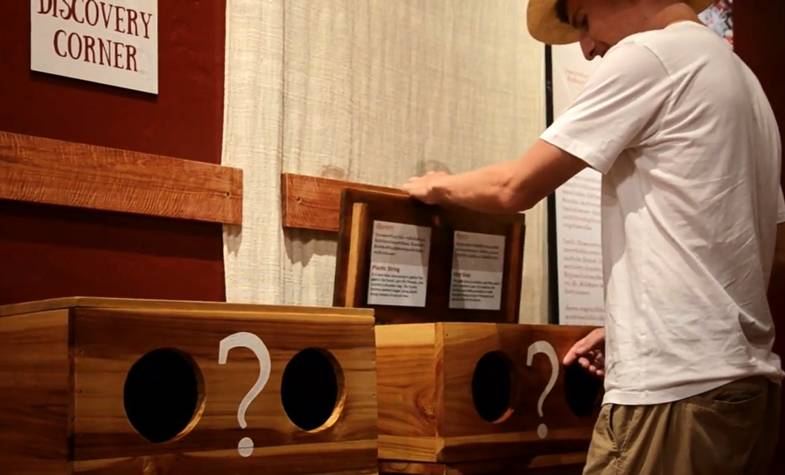
Discovery Corner in Traditional Arts and Ethnology Centre, Laos
Tat Sae Waterfalls
Located about 15km from the city center, Tad Sae Waterfall is a spectacular natural wonder you can enjoy during the wet season in Luang Prabang.
Despite not being as high as Kuang Si waterfall, the cascades have a lot more streams of water pouring over its unique limestone formations. You can also swim in large pools below the falls.
Less famous than Kuang Si and less crowded and quieter, Tad Sae waterfall is a perfect destination for people who love quietness. It is exactly the definition of chilling and tranquility. You can even come here alone and enjoy a good time in your way. You are chilling and harmonizing with the beautiful nature, a little noisy of the thunder-sound from the waterfall, a little quietness of the forest, fewer activities of other people. All those things create a wonderful Tad Sae waterfall, not famous but worth a visit.
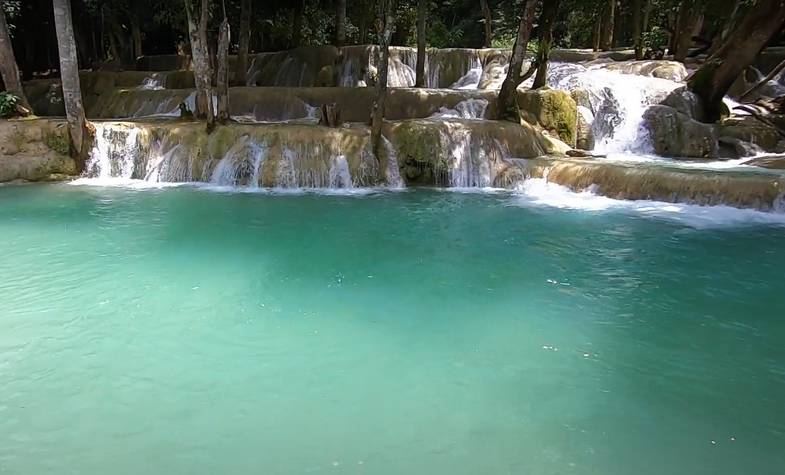
Tat Sae Waterfalls, Luang Prabang, Laos
Best time to visit:
The best time to visit Tad Sae Waterfall is from August to November.
Tad Sae waterfalls is also a favorite place for local people during the weekend, so it is better if you can go on weekdays.
Opening hours: 8:00 AM to 5:30 PM.
The Living Land Farm
Locates in Ban Phong Van, Luang Prabang Town, Luang Prabang Province. It is about 5 km outside Luang Prabang on the road to the Kuangsi Waterfall.
Founded in 2005 by a group of local people, to propose to make better use of their land, share experiences with others, and build an organic vegetable garden. Over the years, this has developed into the community farm craft centre and organic farm.
Visitors go to the Farm to learn how rice is grown and to experience the life of a typical Lao farmer. This tour offers a unique experience, for real local life, local food with typical Lao dishes served in traditional style, and support local people.
Part of profits is reserved to get back to the community to support disadvantaged locals, especially children in poor families, people with low educational skills or physical handicaps, etc.
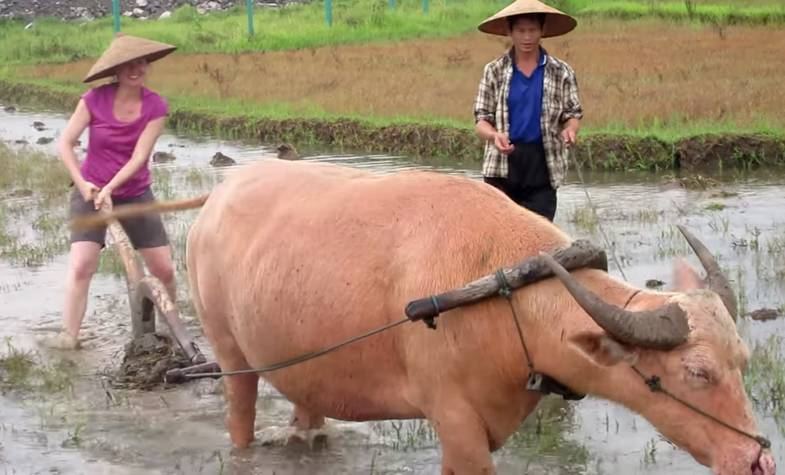
The Living Land Farm, Laos
What to do – How is the tour:
You can choose between several options tours at Living Land Farm: half-day, full-day, with or without lunch.
Due to the limits of available seats, it is preferable to book in advance.
UXO Laos Information Centre
The sobering UXO Laos Information Centre helps you get a grip on the wreckage Laos suffered in the Second Indochina War and how nearly 40 years later death or damage from unexploded ordnance (UXO) remains an everyday reality in several provinces including Phonsavan.
The UXO Lao Visitors Centre in Luang Prabang is an educational centre where visitors can learn about the problems caused by unexploded bombs and mines left behind by American armed forces after the end of the Vietnam War and the brave work of the Lao National Unexploded Ordnance Programme (UXO Lao) to clear this dangerous ordnance.
Wat Xieng Thong
Wat Xieng Thong is the best-known monastery and one of the largest Buddhist temples (vat or wat) in Luang Prabang. A symbol of great historic importance, its structure has features of 16th-century Lao architecture, with a stunning ‘tree of life’ mosaic set on its western exterior wall, rare Buddhist deities, and a 12-meter-tall memorial carriage.
Wat Xieng Thong is an important gathering site that remains a significant monument to the spirit of religion, royalty, and traditional art. The temple remains in its original structure, with repairs undertaken to the roof, gold leaf gilding, and lacquering added to the walls and entrance.
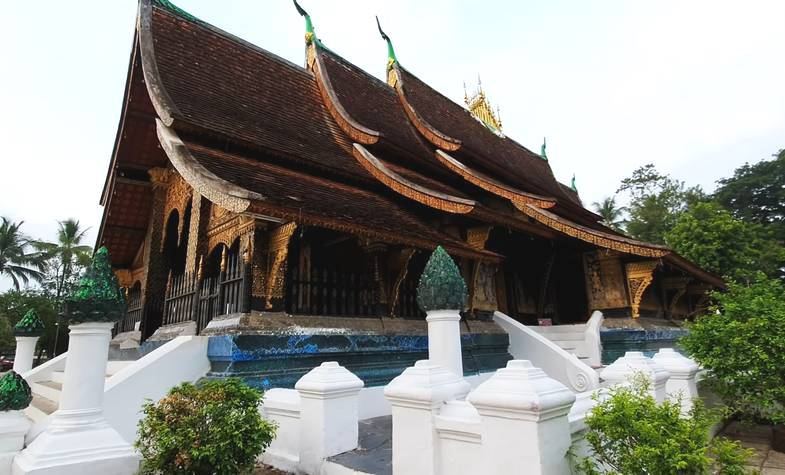
Wat Xieng Thong, Luang Prabang, Laos
Discover sacred and beautiful Laos with Travel Authentic Asia. Please contact us for more information and the best support.

